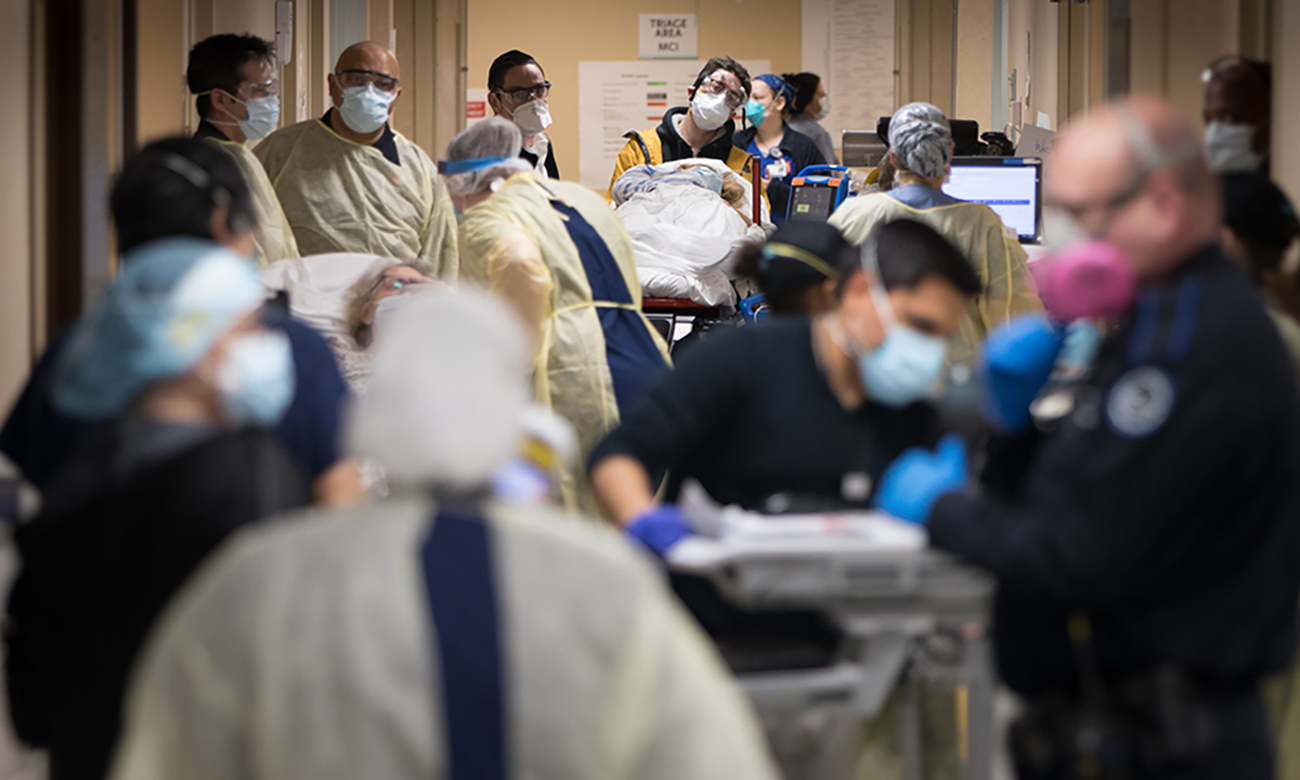
美国医院经受住了疫情最艰难时期的考验,但由于非急需施行的手术被取消,医院遭遇了到目前为止最严重的财务危机。图片来源:JEFFREY BASINGER- NEWSDAY - GETTY IMAGES
过去两年,由于新冠疫情肆虐,医疗保健行业变得与所有人的生活都息息相关。在全民急需医疗服务的时刻,美国的医疗保健服务提供商们英勇无畏,而且即使又爆发了一波疫情,但至少从临床的角度,他们显然已经度过了最严重的时期。
了解医疗保健提供商目前的财务状况同样至关重要。医疗保健行业是美国经济规模最大的行业,美国每年医疗保健支出超过4万亿美元。其中超过一半支出需要由医疗保健提供商经手。他们的财务健康状况至关重要,因为一方面他们为人们提供不可或缺的护理,另一方面大部分医疗保健提供商都是其所服务社区最大的雇主。
医疗保健行业遭遇了史上最严重的财务危机,许多医院因为患者数量大幅减少而濒临倒闭。好消息是随着我们逐步走出疫情的阴霾,该行业即将迎来强势反弹。
为了更深入地了解美国医疗保健服务提供商的财务现状,我于上周在第40届摩根大通医疗健康年会(40th Annual JP Morgan Healthcare Conference)上了解了非营利性医疗服务提供商的状况。有20家美国最杰出的医疗系统的首席执行官和首席财务官在此次大会上作了报告,这20家机构代表了近2500亿美元的年度医疗保健支出。
医疗保健行业的财务健康状况
演讲嘉宾明确指出,美国业内领先的医疗系统经过V字型复苏,已经完全恢复元气。2020年3月,由于非急需施行的手术被取消,美国医院的患者数量减少了近30%。目前,患者数量已经恢复到接近疫情之前的水平,收入和利润率均大幅回升。
但大医院的情况并不适合社区医疗服务提供商。Strata与400多家医疗保健服务系统和2000家医院合作。许多小型医疗保健服务提供商依旧利润微薄。
虽然未来依旧面临着严峻挑战,但许多医疗系统的财务状况已经显著好转。长期陷入困境的医院终于迎来了喘息之机。现在他们有精力着眼于未来进行战略思考。
未来的主要策略
通过收入多样化推动可持续增长是此次会议的主题,未来策略主要涉及五个关键领域:
并购:并购仍然是未来的策略之一。例如,犹他州的Intermountain Healthcare最近收购了科罗拉多州的SCL Health,南卡罗来纳州的Prisma Health正在评估在北卡罗来纳州和田纳西州的潜在发展机会。
创新投资:2021年,医疗创新融资规模翻了一番,达到440亿美元,医疗系统在其中发挥了积极作用。例如,伊利诺伊州的Advocate Health Care在一家数字医疗公司拥有17%的股权,并100%拥有一家老年人居家护理和健康解决方案提供商。此外,马萨诸塞州的Mass General Brigham和Northwell Health旗下的营利性子公司Northwell Holdings & Ventures发起了5亿美元风险投资计划。
基于价值与风险的合同:医疗保健行业继续向“为价值付费”的模式转变。Intermountain基于价值的合同所带来的收入,现在超过了传统的“为服务付费”业务的收入。宾夕法尼亚州的Jefferson Health公司30%的收入与完全基于风险的模式有关,这种收入模式将医疗服务付费与医疗服务的成本和质量挂钩。
打造目的地医疗中心:打造“目的地”专业医疗中心,是大型医疗系统目前正在探索的策略之一,涉及矫形外科等传统领域以及行为和精神健康等较新的领域。比如,密歇根州的Henry Ford Health正在建设新医疗设施,预计将为其增加170万患者,创造22亿美元收入。
部署虚拟护理平台:医疗系统着手扩大市场的同时,希望通过一种对人力资本要求较低的护理模式解决当前人手不足的问题。例如,费城儿童医院(Children’s Hospital of Philadelphia)在大会上表示,数字化将成为其增长的关键驱动因素,Mass General Brigham在2021年虚拟接诊超过200万次。
无论从临床还是财务的角度,美国的医疗保健服务提供商都已经经受住了疫情的考验。他们顺利度过了一系列可怕的挑战,并且大多数提供商都能够维持财务稳定。现在,他们可以着手关注亟待解决的许多与美国人健康有关的其他问题。
虽然过去两年我们都历尽艰辛,但我们可以并且应该为医疗保健行业史上最强势的复苏欢呼。(财富中文网)
本文作者丹·米切尔森现任位于芝加哥的Strata Decision Technology公司的首席执行官。该公司提供基于云的财务规划、分析和绩效平台,服务美国400个医疗系统旗下的2000多家医院,其客户涵盖了美国一半以上的医疗保健服务提供商。
翻译:刘进龙
审校:汪皓
过去两年,由于新冠疫情肆虐,医疗保健行业变得与所有人的生活都息息相关。在全民急需医疗服务的时刻,美国的医疗保健服务提供商们英勇无畏,而且即使又爆发了一波疫情,但至少从临床的角度,他们显然已经度过了最严重的时期。
了解医疗保健提供商目前的财务状况同样至关重要。医疗保健行业是美国经济规模最大的行业,美国每年医疗保健支出超过4万亿美元。其中超过一半支出需要由医疗保健提供商经手。他们的财务健康状况至关重要,因为一方面他们为人们提供不可或缺的护理,另一方面大部分医疗保健提供商都是其所服务社区最大的雇主。
医疗保健行业遭遇了史上最严重的财务危机,许多医院因为患者数量大幅减少而濒临倒闭。好消息是随着我们逐步走出疫情的阴霾,该行业即将迎来强势反弹。
为了更深入地了解美国医疗保健服务提供商的财务现状,我于上周在第40届摩根大通医疗健康年会(40th Annual JP Morgan Healthcare Conference)上了解了非营利性医疗服务提供商的状况。有20家美国最杰出的医疗系统的首席执行官和首席财务官在此次大会上作了报告,这20家机构代表了近2500亿美元的年度医疗保健支出。
医疗保健行业的财务健康状况
演讲嘉宾明确指出,美国业内领先的医疗系统经过V字型复苏,已经完全恢复元气。2020年3月,由于非急需施行的手术被取消,美国医院的患者数量减少了近30%。目前,患者数量已经恢复到接近疫情之前的水平,收入和利润率均大幅回升。
但大医院的情况并不适合社区医疗服务提供商。Strata与400多家医疗保健服务系统和2000家医院合作。许多小型医疗保健服务提供商依旧利润微薄。
虽然未来依旧面临着严峻挑战,但许多医疗系统的财务状况已经显著好转。长期陷入困境的医院终于迎来了喘息之机。现在他们有精力着眼于未来进行战略思考。
未来的主要策略
通过收入多样化推动可持续增长是此次会议的主题,未来策略主要涉及五个关键领域:
并购:并购仍然是未来的策略之一。例如,犹他州的Intermountain Healthcare最近收购了科罗拉多州的SCL Health,南卡罗来纳州的Prisma Health正在评估在北卡罗来纳州和田纳西州的潜在发展机会。
创新投资:2021年,医疗创新融资规模翻了一番,达到440亿美元,医疗系统在其中发挥了积极作用。例如,伊利诺伊州的Advocate Health Care在一家数字医疗公司拥有17%的股权,并100%拥有一家老年人居家护理和健康解决方案提供商。此外,马萨诸塞州的Mass General Brigham和Northwell Health旗下的营利性子公司Northwell Holdings & Ventures发起了5亿美元风险投资计划。
基于价值与风险的合同:医疗保健行业继续向“为价值付费”的模式转变。Intermountain基于价值的合同所带来的收入,现在超过了传统的“为服务付费”业务的收入。宾夕法尼亚州的Jefferson Health公司30%的收入与完全基于风险的模式有关,这种收入模式将医疗服务付费与医疗服务的成本和质量挂钩。
打造目的地医疗中心:打造“目的地”专业医疗中心,是大型医疗系统目前正在探索的策略之一,涉及矫形外科等传统领域以及行为和精神健康等较新的领域。比如,密歇根州的Henry Ford Health正在建设新医疗设施,预计将为其增加170万患者,创造22亿美元收入。
部署虚拟护理平台:医疗系统着手扩大市场的同时,希望通过一种对人力资本要求较低的护理模式解决当前人手不足的问题。例如,费城儿童医院(Children’s Hospital of Philadelphia)在大会上表示,数字化将成为其增长的关键驱动因素,Mass General Brigham在2021年虚拟接诊超过200万次。
无论从临床还是财务的角度,美国的医疗保健服务提供商都已经经受住了疫情的考验。他们顺利度过了一系列可怕的挑战,并且大多数提供商都能够维持财务稳定。现在,他们可以着手关注亟待解决的许多与美国人健康有关的其他问题。
虽然过去两年我们都历尽艰辛,但我们可以并且应该为医疗保健行业史上最强势的复苏欢呼。(财富中文网)
本文作者丹·米切尔森现任位于芝加哥的Strata Decision Technology公司的首席执行官。该公司提供基于云的财务规划、分析和绩效平台,服务美国400个医疗系统旗下的2000多家医院,其客户涵盖了美国一半以上的医疗保健服务提供商。
翻译:刘进龙
审校:汪皓
Over the last two years, health care has been at the center of our lives due to the COVID-19 pandemic. Our nation’s health care providers responded heroically in our time of need, and even as another wave hits, it’s clear they have weathered the worst of the storm, at least from a clinical perspective.
Understanding the current financial health of health care is also important. It's the biggest industry in our economy with over $4 trillion in annual spending. Over half of that spending flows through our nation’s health care providers. Their financial health is critical, not only so that they can provide us with the care that we need, but also because most are the largest employer in the communities they serve.
Behind the scenes, this was the biggest financial crisis in the history of health care, with many hospitals running on life support due to the dramatic drop in patient volume. The good news? As we emerge from the pandemic, the stage has been set for what could be a stunning comeback.
To better understand the current financial condition of our nation’s health care providers, the place to go last week was the non-profit provider track at the 40th Annual JP Morgan Healthcare Conference, which featured presentations from CEOs and CFOs of 20 of the nation’s most prominent health systems, representing nearly $250 billion in collective annual spend.
The financial health of health care
Speakers were clear that our nation’s top health systems have completed their comeback with essentially a V-shaped recovery. Overall, patient volume dipped nearly 30% in March of 2020 as elective surgeries were canceled. Volume is now back closer to where it was pre-pandemic, with a strong recovery in revenue and margins.
However, the experience of large hospitals doesn’t necessarily extend to community providers. At Strata, we work with over 400 health care delivery systems and 2,000 hospitals. For many smaller providers, margins are still razor-thin.
While there are still major challenges ahead, many health systems have made a remarkable comeback from a financial perspective. The hospitals that fell below the surface for a long time are finally able to breathe again. They now have the bandwidth to think strategically and look to the future.
Top strategies going forward
Diversifying revenue streams to drive sustainable growth was the primary theme at the conference, with strategies falling into five key areas:
Mergers and acquisitions: M&A continues to be part of the playbook. For example, Intermountain Healthcare in Utah recently acquired of SCL Health in Colorado, and Prisma Health in South Carolina is evaluating potential opportunities in North Carolina and Tennessee.
Investing in Innovation: Health innovation funding doubled in 2021 to $44B, with health systems playing an active role. Advocate Health Care in Illinois, for example, has 17% ownership in a digital health company and 100% ownership in a homecare and wellness solution for seniors. There are other examples, such as the $500M VC initiative from Mass General Brigham in Massachusetts and Northwell Health’s for-profit subsidiary called Northwell Holdings & Ventures.
Value and risk-based contracts: Health care continues to move toward a fee-for-value model. Intermountain’s revenue from value-based contracts now exceeds traditional, fee-for-service revenue. About 30% of Pennsylvania-based Jefferson Health’s revenue is tied up in full, risk-based models, a form of reimbursement that ties payments for care delivery to both the cost and the quality of care provided.
Creating destination centers: Building “destination” specialty centers is another strategy large health systems are exploring, both in traditional areas like orthopedics and newer areas like behavioral and mental health. For example, Henry Ford Health in Michigan is building new facilities and expects to generate an incremental 1.7 million visits and $2.2 billion in revenue.
Deploying virtual care platforms: Health systems are looking to extend their market reach and simultaneously address the ongoing labor shortage through a care modality with a less intensive human capital requirement. Children’s Hospital of Philadelphia, for example, shared that digital will be the key enabler of their growth, and Mass General Brigham had over two million virtual visits in 2021.
Our nation’s health care providers stepped up and weathered the pandemic from both a clinical and financial perspective. They have been able to manage through a series of overwhelming challenges and most are on solid ground from a financial perspective. They can now start focusing on the many other issues we need to address relative to the health of the nation.
While the last two years have been hard on all of us, we can and should collectively celebrate the greatest comeback in the history of health care.
Dan Michelson is the CEO of Chicago-based Strata Decision Technology, which provides a cloud-based financial planning, analytics and performance platform supporting a customer base of over 2,000 hospitals in 400 health systems, representing over half of the health care providers in the U.S.






